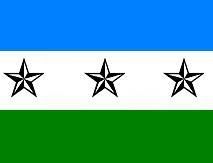Central Prestonia
This article is incomplete because it is pending further input from participants, or it is a work-in-progress by one author.
Please comment on this article's talk page to share your input, comments and questions.
Note: To contribute to this article, you may need to ask the permission of the author(s) to edit this page.
| |||
| Motto: United We Shall Triumph | |||
| Spoken Languages - De-facto |
English, Russian, Volscian | ||
| Capital | Hudson | ||
| Leader | President Justin M. Gannon | ||
| Area - Total - % water |
km² | ||
| Population - Total (2007) |
approximately 600 million | ||
| Establishment - Current Form |
June 18th, 2007 | ||
| Government Type | American System | ||
| Constitutional Form | Federal republic | ||
| GDP (2005) - Total (USD) - GDP/capita (USD) |
$33,605 | ||
| GDP Growth Rate: | 4.38% | ||
| Unemployment: | 3.81% | ||
| Currency | 1 Prestonian Dollar (P$) = 100 cents (c)) | ||
| International Abbreviations | FHRCP, FHRP | ||
| Naval Craft Classification - Prestonian Navy - Prestonian Merchant Marines - Prestonian Coast Guard |
RPS PMMS PCGS | ||
| National Anthem | Rise, O Voices of Prestonia | ||
| Internet TLD | .cp | ||
| Calling Code | +27 | ||
The Federal Havenic Republic of Central Prestonia occupies a large peninsule on the south-central continent of Haven. The landmass is comprised of the peninsula, two major islands, and a chain of several smaller ones. It borders the Aralonian Channel and Ambrose Sea on the south and east, and Kashmire on the west. The nation also borders unclaimed land to the northwest, which it once attempted to annex.
Contents
History
Ancient Prestonia
The land known as Prestonia first shows up in text circa 500 AD, where it is mentioned in an epic poem of unknown origin. The land was among the last to in Haven to be settled, with the arrival of refugees from The Phoenix War in Vetaka around 1100 AD. it is unknown why the land was never settled prior to this, but the swift currents and imposing mountains may have played a role. From their arrival until the arrival of the British, the Black Phoenix, as they were known, ruled the area, staying relatively isolated from the rest of Haven.
British Rule
In 1703 The King granted an expedition led by Lord Stanley Preston the right to claim as a proprietary colony any land it could find within Haven. After a yearlong journey, the party landed at Cape Leonard on September 25th 1704, and christened it Central Prestonia after it's founder and location within Haven (Haven would not be fully charted for some 100 more years). This did not bode well with the Black Phoenix, and the parties warred off and on from 1704-1710, with the British eventually prevailing. The Black Phoenix, weakened by war and smallpox, were pushed back to the Washington Mountains, where the bulk of their tribe resides today. Prestonia thereafter proved to be a valuable source of precious metals, coal, and later oil. Perhaps it's most important crop, however, was the citrus that grew inland. It had long been known that citric acid was a cure for scurvy, but keeping fresh fruit proved to be a problem. Under the guidance of the Colonial Governor Thomas Windsor-Smythe, large plantations were set up, and the fruit delivered to coastal cities such as Seaside, St. Andrews and Cape Leonard. Ships would stop off in these settlements, which grew into major trade hubs well into the 19th century. However, the relationship with Prestonia and the Crown soured quickly as the United Kingdom began making higher demands for taxes and resources. Revolts occurred in 1785, 1821, and 1900, each time being put down with much bloodshed.
=The World Wars
Despite the rebellions, Prestonians remained loyal to their King when needed. In World War One the Hudson Volunteer Regiment saw extensive combat at The Battle of the Marne, earning 30 Victoria Crosses. This was just one example of Prestonian valor, which was played out in all theaters of the war. In World War Two, the area saw less action than before, as the period between the wars had weakened the British economy, causing a withdrawal of the Prestonian Colonial Protection Force. Unguarded and in the midst of a depression, the area was easy prey for Japanese forces, who overran it in May of 1940 and captured Hudson by July. In stark contrast to the treatment of other areas, the Japanese were by all accounts benevolent masters. Nevertheless, there exist records of frequent attacks upon Japanese assets by resistance groups. The peninsula was finally liberated by the Americans in August of 1944, and turned over to British rule postwar. The war left a permanent mark on Central Prestonia, with several Japanese POWs choosing to stay rather than return to the Emperor. This laid the foundation of the large Japanese culture which exists today.
The Revolution
The Preston Era
Present-Day Prestonia
Government
Culture
Economy
Military
Prestonian Army
Prestonian Air Force
Prestonian Marines
| Nations of Haven |
|---|
| Nations: | Allanea | Ato-Sara | Aunesia | Cravan | Edolia | Franberry | Foe Hammer | Hallad | Hamptonshire | Hattia | Hogsweat | Izistan | Jaredcohenia | Kampfers | Mauvasia | Midlonia | No_Endorse | Okielahoma| Omz222 | Praetonia | Questers | Scandavian States | Skinny87 | Velkya | Willink | Whyatica |

